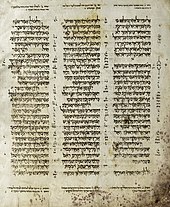Biblical manuscript
| Part of a series on the |
| Bible |
|---|
 |
|
Outline of Bible-related topics |
A biblical manuscript is any handwritten copy of a portion of the text of the Bible. Biblical manuscripts vary in size from tiny scrolls containing individual verses of the Jewish scriptures (see Tefillin) to huge polyglot codices (multi-lingual books) containing both the Hebrew Bible (Tanakh) and the New Testament, as well as extracanonical works.
The study of biblical manuscripts is important because handwritten copies of books can contain errors. Textual criticism attempts to reconstruct the original text of books, especially those published prior to the invention of the printing press.
Hebrew Bible (or Tanakh) manuscripts[]

The Aleppo Codex (c. 920 CE) and Leningrad Codex (c. 1008 CE) were once the oldest known manuscripts of the Tanakh in Hebrew. In 1947 CE the finding of the Dead Sea scrolls at Qumran pushed the manuscript history of the Tanakh back a millennium from such codices. Before this discovery, the earliest extant manuscripts of the Old Testament were in Greek, in manuscripts such as the Codex Vaticanus and Codex Sinaiticus. Out of the roughly 800 manuscripts found at Qumran, 220 are from the Tanakh. Every book of the Tanakh is represented except for the Book of Esther; however, most are fragmentary. Notably, there are two scrolls of the Book of Isaiah, one complete (1QIsa), and one around 75% complete (1QIsb). These manuscripts generally date between 150 BCE to 70 CE.[1]
Extant Tanakh manuscripts[]
| Version | Examples | Language | Date of Composition | Oldest Copy | ||||||
|---|---|---|---|---|---|---|---|---|---|---|
| Ketef Hinnom scrolls | Hebrew written in the Paleo-Hebrew alphabet | c. 650–587 BCE | c. 650–587 BCE[2] (amulets with the Priestly Blessing recorded in the Book of Numbers) | |||||||
| Dead Sea Scrolls | Hebrew, Aramaic, and Greek | c. 150 BCE – 70 CE | c. 150 BCE – 70 CE (fragments) | |||||||
| Septuagint | Codex Vaticanus, Codex Sinaiticus and other earlier papyri | Greek | 300–100 BCE | 2nd century BCE (fragments) 4th century CE (complete) | ||||||
| Peshitta | Syriac | early 5th century CE | ||||||||
| Vulgate | Codex Amiatinus | Latin | early 5th century CE early 8th century CE (complete) | |||||||
| Masoretic | Aleppo Codex, Leningrad Codex and other, incomplete MSS[a] | Hebrew | c. 100 CE | 10th century CE (complete) | ||||||
| Samaritan Pentateuch | Hebrew | 200–100 BCE | Oldest extant MSS, c. 11th century CE; oldest MSS available to scholars, 16th century CE | |||||||
| Targum | Aramaic | 500–1000 C E | 5th century CE | |||||||
| Coptic | Crosby-Schøyen Codex, British Library MS. Oriental 7594 | Coptic | 3rd or 4th century CE | |||||||
New Testament manuscripts[]

The New Testament has been preserved in more manuscripts than any other ancient work of literature, with over 5,800 complete or fragmented Greek manuscripts catalogued, 10,000 Latin manuscripts and 9,300 manuscripts in various other ancient languages including Syriac, Slavic, Gothic, Ethiopic, Coptic and Armenian. The dates of these manuscripts range from c. 125 (the